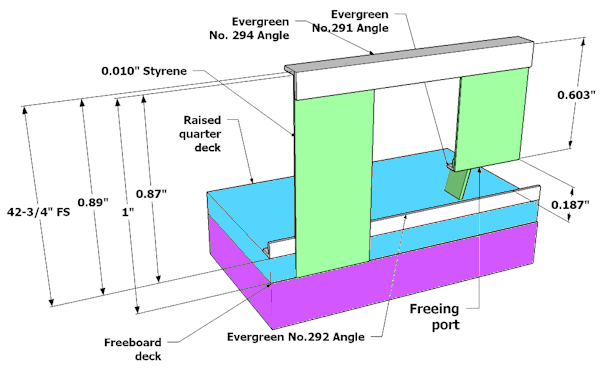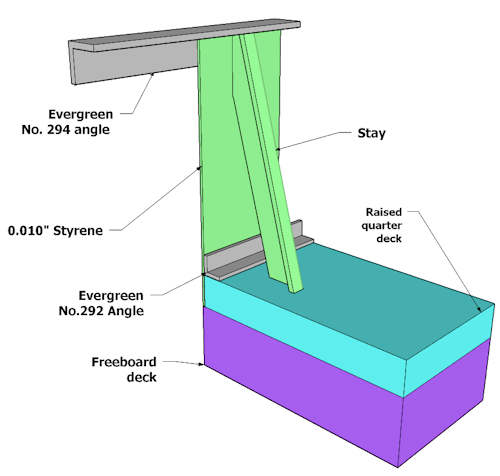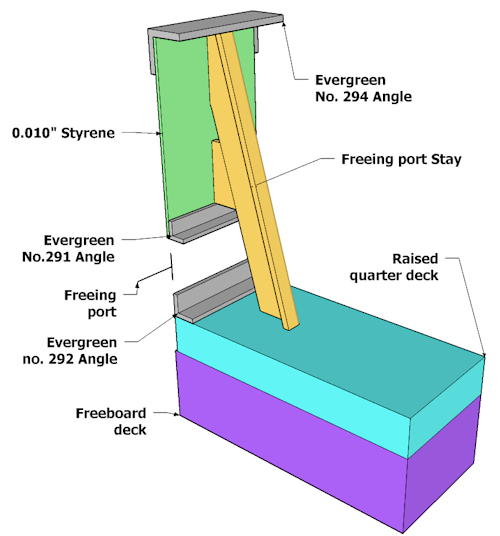Bulwark – In naval terms, a bulwark refers to a solid, raised structure along the side of a ship above the deck, serving as a protective barrier against the elements and providing security. Since I am gathering information to build bulwarks for Grazyna’s Muse I figured I might as well do that here. I am using a document from the International Maritime Organization (IMO); Regulation 3-1 – Structural, mechanical and electrical requirements for ships; Section 5 Bulwarks, guard rails and other means for the protection of crew. I love the research for things like this and rather then just stick something on the deck and call it a bulwark but since the internet allows something “more” … I say .. “Why not”?
I want to raise the deck height to both the bow and stern set back from the sides of the ship to allow securely attaching bulwarks. I have some 1/8″ plywood that I can use for this by making this “Raised Quarter Deck” slightly smaller then the deck, offsetting enough to create a ledge to attach the bulwark to.
5.1.1 Bulwarks or guard rails are to be provided around all exposed decks. Bulwarks or guard rails are to be not less than 1,0 m in height measured above sheathing, and are to be constructed as required by this Section. Consideration will be given to cases where this height would interfere with the normal operation of the ship. (That last bit applies to the area along the cargo hatch)
9.1.11 Handrails are to be fitted at a height of not less than 1 m, measured from the top of the rail to the deck. Handrails should be made of steel tubes of 42,4 mm outside diameter, with a wall thickness of at least 2,6 mm. (42,4 mm = 1.67″. The Evergreen No. 294 I want to use for the cap is 0.125″ .. 6″ full-size. Evergreen No. 291 is oversize at 2.88″ full-size but we need to have a visual difference t the various angles used. I don’t think going below No. 292 angle would be good.

I decided to use sheet styrene for the bulwark. Steel 1/4″ thick would be about 0.005″ in 1:48 .. but I think 0.010″ would be better since the thickness will not be visible due to a cap rail. The minimum height of the bulwark or guard rail from 5.11 above is 1 m. This would be ~0.82″ in 1:48 scale. The Raised Deck Quarter (aqua) sits 0.130″ above the Freeboard deck (purple). Since 1″ is easy to see on a ruler, cut styrene strips (green) this wide. They sit on the freeboard deck and sit proud 0.87″, The Rail Cap (Evergreen No.294 Angle is 0.020″ thick). Add 0.87″+0.020″ = 0.97″. The top of the cap rail is 0.89″ or ~42-3/4″.
This is of course at this point somewhat speculative but I think might work. Note that the Raised Quarter Deck is offset the thickness of the Bulwark/Styrene the 0.010″ thickness of the plastic.
There are two designs for the Bulwark. (1) a full sheet and (2) a gap at the bottom to allow water to leave (Freeing Port)

Full Bulwark: Here the 0.010″ styrene runs from the No. 294 Evergreen angle (cap) down the the Freeboard Deck. The Raised Quarter Deck is 0.130″ thick and stepped back 0.010″ to allow gluing the bottom of the styrene to the face. In addition a No. 292 Evergreen angle reinforces that joint.

Freeing Port: Here the 0.010″ styrene stops 0.187″ shy of the No. 292 angle forming the Freeing Port. A length of No. 291 angle stiffens the bottom edge. The backing stay has a piece extending to that angle to reinforce the bottom of the styrene.
There are complicated maths involved in how far apart you place stanchions, where stays are required, where a freeing port is placed.
5.1.3 Guard rails fitted on superstructure and freeboards decks are to have at least three courses. The opening below the lowest course of guard rails is not to exceed 230 mm. (9″ .. or .. 3/16″ in 1:48)
5.1.4 Guard rails are to be fitted with fixed, removable or hinged stanchions fitted no more than 1,5 m apart. Removable or hinged stanchions shall be capable of being locked in the upright position. ( there is a lot of variation based on type of ship etc. which I will ignore).
5.1.5 At least every third stanchion is to be supported by a stay. (there are “In lieu of this” by increasing the breath of the stanchions, welding, minimal leg size, et.)
5.1.6 Where necessary for the normal operation of the ship, steel wire ropes may be accepted in lieu of guard rails. Wires are to be made taut by means of turnbuckles. Chains are only permitted in short lengths in way of access openings. (I assume this is in my example, access to the cargo hatch).
5.3.3 Where bulwarks on the weather portions of freeboard or superstructure decks form wells, ample provision is to be made for rapidly freeing the decks of large quantities of water by means of freeing ports, and also for draining them. (The Grazyna is about 100 feet / 30.5 m in length. The rules here talks about wells 20 m or less and where it exceeds 20 m. A quick look and the rear superstructure .. and I assume associated bulwark is about 8″ (1:48) or 32 ft. full-size or ~ 10 m. The forward superstructure about 10″ (1:48) or 40 ft. full-size or ~12 m.)
- Rear Bulwark at 10 m. – then 0.7 + (0.035 * 10) = 1.05 sq. m. In 1:48 then 0.7 + (0.035 * 8) = 0.98 sq. in. Since the 1:48 Freeing port is 3/16″ then a rectangle 0.1875″ x 5.2″ is needed.
- Forward Bulwark at 12 m. – then 0.7 + (0.035 * 12) = 1.12 sq. m. In 1:48 then 0.7 + (0.035 * 10) – 1.05 sq. in. Since the 1:48 Freeing port is 3/16″ then a rectangle 0.1875″ x 5.6″ is needed.
